Japanese Sweet-Simmered Vegetables with Steamed Rice
I’ve been cooking a lot of Japanese food lately, inspired by our recent trip to Mitsuwa marketplace. I love shopping there because I always discover something new and it allows me to expand my culinary repertoire. Plus, it’s home to one of the tastiest ramen bars in Chicago.
Groceries from Our Recent Trip to Mitsuwa Marketplace
Last week, I created this refreshing sashimi salad featuring fresh ingredients from the sea. This week, I focused on a very different style of Japanese cooking, what I consider Japanese comfort food. Japanese sweet-simmered vegetables is a hearty, filling dish and the delicious sweet-and-salty broth is perfect during the cold winter months. When paired with steamed rice, you have a perfectly satisfying meal.
A Note on the Ingredients
Dried Shiitake Mushrooms: Shiitake mushrooms that have been dehydrated. They need to be rehydrated before cooking. Shiitake mushrooms have large caps and long, thin stems. The stems are typically not consumed as they’re tough. Shiitake mushrooms have a slightly sweet, earthy taste.
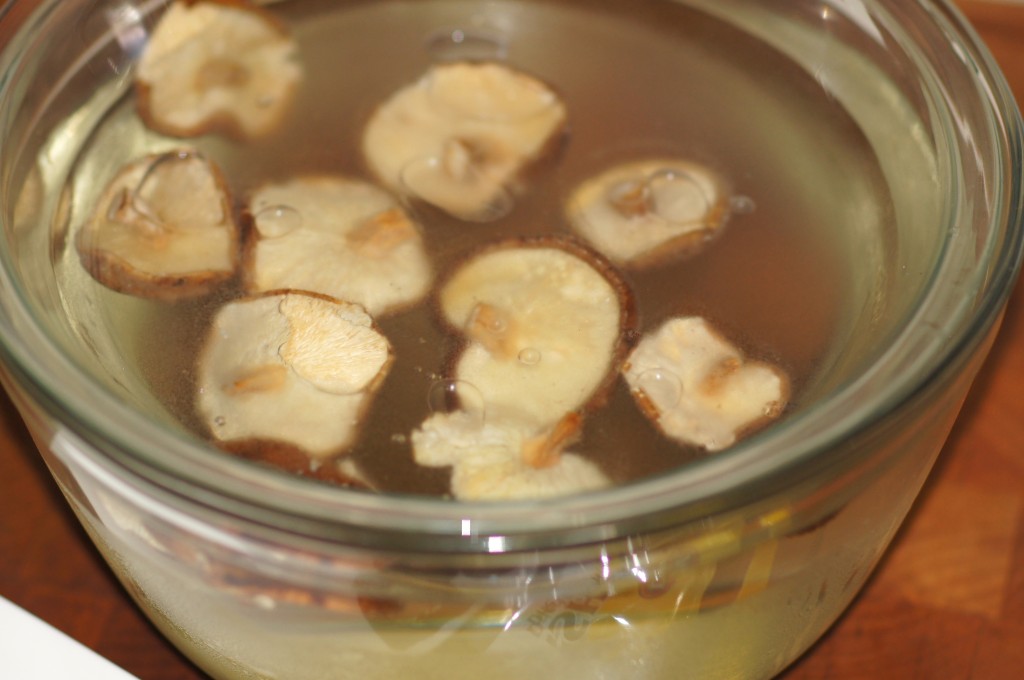 How to Rehydrate Dried Shiitake Mushrooms: Place mushrooms in a bowl of water. Weight them down with a plate (I used a glass pie plate) to keep them submerged. Let them soak for 40-to-60 minutes, then flip the mushrooms over and soak for an additional 40-to-60 minutes.
How to Rehydrate Dried Shiitake Mushrooms: Place mushrooms in a bowl of water. Weight them down with a plate (I used a glass pie plate) to keep them submerged. Let them soak for 40-to-60 minutes, then flip the mushrooms over and soak for an additional 40-to-60 minutes.
Dry Shiitake Mushrooms Rehydrating in Bowl of Water
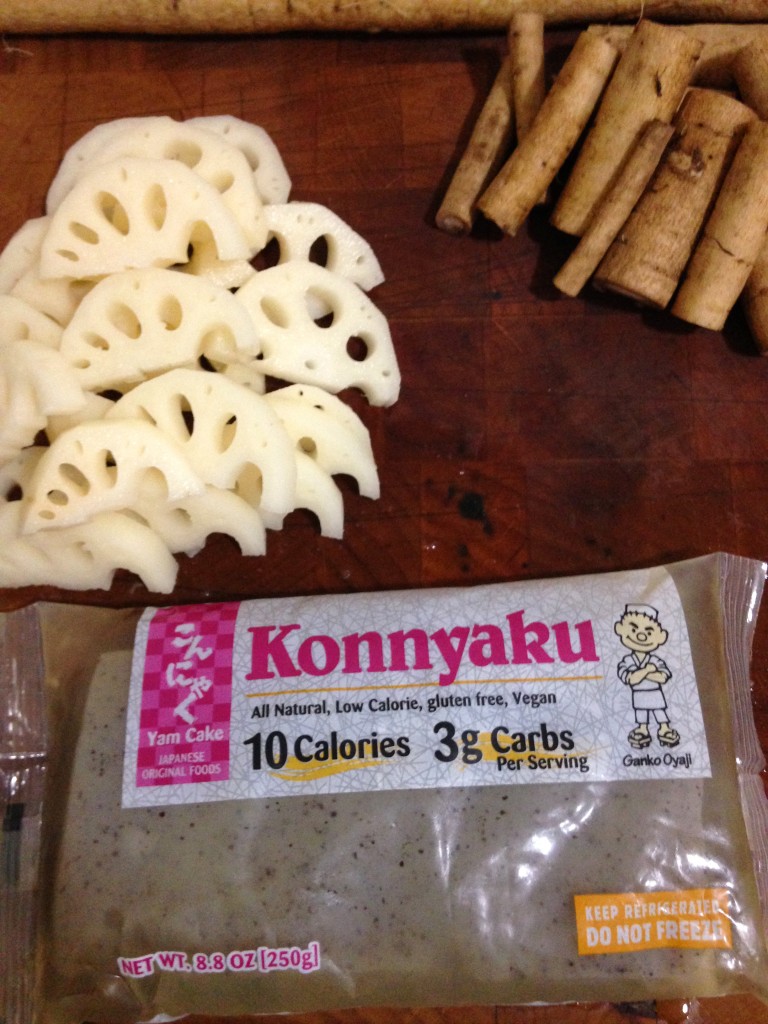 Clockwise Top Right: Burdock Root, Devil’s Tongue Jelly, and Lotus Root
Clockwise Top Right: Burdock Root, Devil’s Tongue Jelly, and Lotus Root
Devil’s Tongue Jelly (Konnyaku): Is a gelatinous mixture made from the devil’s tongue plant. It’s often sold in rectangular blocks. It’s gray with black flecks. It’s prized in Japan for having very few calories, almost none; the majority of devil’s tongue jelly is made up of water. However, the texture makes you feel full. Devil’s tongue jelly has virtually no taste on its own, but will absorb whatever flavors it is cooked in.
Canned Bamboo Shoots
A Close Up of the Canned Bamboo Shoots, Quartered
Bamboo Shoots: Are made from the new shoots of bamboo. They are tender and have a delicate flavor. The easily absorb the flavors they are cooked in. They have a great texture due to their ribbed interior.
Clockwise from top left: Lotus Root, Burdock Root, Carrots, Bamboo shoots, and Devil’s Tongue Jelly
Lotus Root: is the root of a lotus plant. The exterior is tannish brown. When the skin is removed, the vegetable is pale white. There are holes throughout the length of the interior of the lotus root. These holes give the vegetable a pretty pattern when sliced. The vegetable is crunchy and fibrous. The taste is very similar to a water chestnut.
Carrots
Chopped Burdock Root
Burdock Root (Gobo): is a root vegetable that is long and slender with brown skin. It can grow up to 3 feet in length. It can be used to make tea, stir fried, or boiled. It has a bitter taste when raw. A lot of the flavor is in the skin, so don’t discard it; just make sure to scrub before using, as it can be quite dirty.
Sugar
Mirin: is a sweet cooking wine commonly used in Japanese cuisine.
Dried Bonito Flakes
Dashi: a stock made from bonito flakes (made from dried, smoked Slipjack tuna) and dried kombu. It is an essential ingredient in Japanese cuisine and is the base for many soups, simmered dishes, and ramen. If you’ve ever had Miso soup, you’ve had dashi.
How to make Kombu-Bonito Dashi:
Ingredients:
- 5 inch kombu
- 2 cups shaved bonito flakes
- 6 cups water
- Wipe kombu with a damp towel (do not remove the flavorful white powder; only remove the sand).
- In a Dutch oven, add the water and the kombu. Raise heat to high. When tiny bubbles form remove the kombu. You want to remove the kombu just before it reaches a boil, otherwise it will release an odor.
- When boiling, add bonito flakes. Remove from heat and let the bonito flakes sink, steep for 2 minutes.
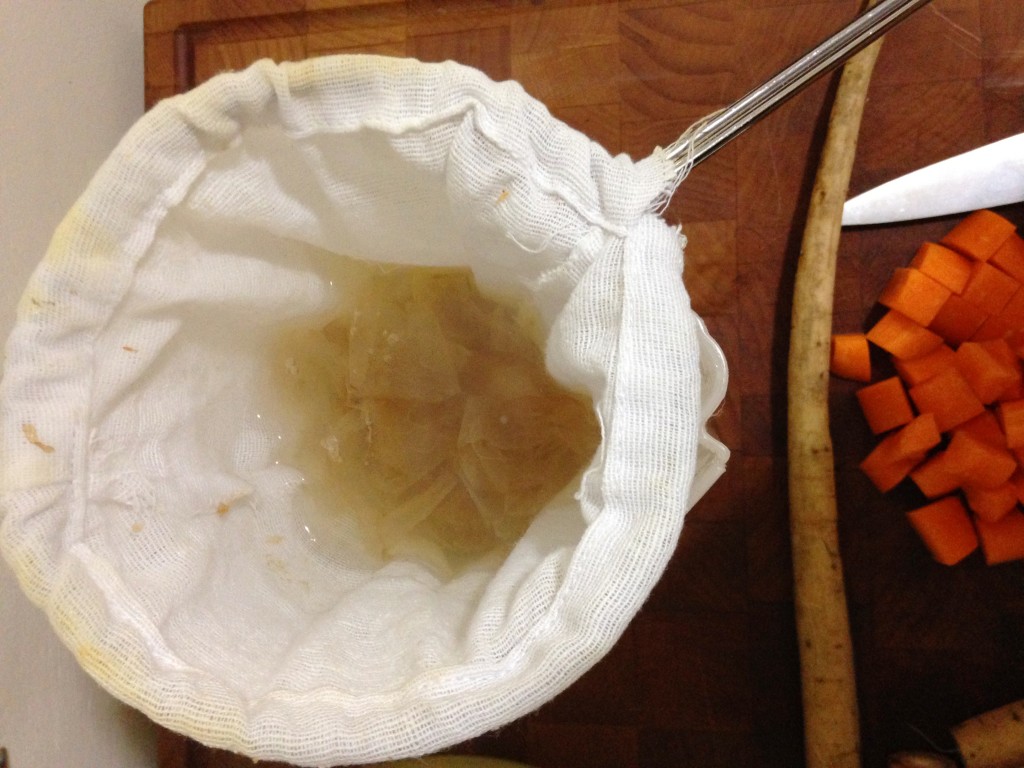
Draining the Dashi Using a Fine Mesh Cheesecloth
- Strain the stock through a cheesecloth or fine mesh sieve. Gently press liquid through. Do not squeeze the cheesecloth as the dashi will become cloudy if you do.
Soy Sauce or Reduced-Sodium Soy Sauce
Snow Peas (optional)
You can buy these ingredients in Asian grocery stores, and some of them can be found in your local grocery store in the ethnic food aisle. The vegetables will be sold in the refrigerated section; all the other ingredients will be located with dried goods.
The Vegetables Simmering in a Sweet-Dashi Broth
This Japanese sweet-simmered vegetable dish is sweet, hearty, and packed full of nutrients. It’s a great introductory dish to Asian vegetables and Japanese cooking techniques. It’s worth making the trip to an Asian grocery store or Japanese market!
Japanese Sweet-Simmered Vegetables with Steamed Rice
If you enjoyed reading this post, like my Facebook page and subscribe to my blog. That way, you’ll never miss a post!
Kombu-Bonito Dashi
| Serves | yields 6 cups |
| Region | Japanese |
| From book | Slightly Adapted from Authentic Japanese Cuisine for Beginners |
Ingredients
- 5 inch kombu
- 2 cups shaved bonito flakes
- 6 cups water
Note
You can buy the ingredients to make dashi in Asian grocery stores. The ingredients will be located in the dried goods section.
Directions
Japanese Sweet-Simmered Vegetables
| Serves | 5 |
| Meal type | Main Dish, Soup |
| Misc | Serve Hot |
| Region | Japanese |
| From book | Adapted from Authentic Japanese Cuisine for Beginners |
Ingredients
- 1 devil's tongue jelly (konnyaku) (cut into 10 squares)
- 1 carrot (chopped)
- 1 burdock root (cut into two inch pieces, skin on)
- 10 dried shiitake mushrooms
- 1 can bamboo shoots (quartered)
- 1 piece lotus root (peeled and sliced into 1/3 inch half circles)
- 1 cup sugar
- 1 cup mirin
- 5 cups dashi
- 1/2 cup soy sauce (or reduced sodium soy sauce)
Optional
- 15 snow peas, steamed (for garnish)
Note
* You can buy these ingredients in Asian grocery stores, and some of them can be found in your local grocery store in the ethnic food aisle. The vegetables will be sold in the refrigerated section; all the other ingredients will be located with dried goods.
* The shiitake mushrooms need to rehydrated. Please note that this takes 80 to 120 minutes.


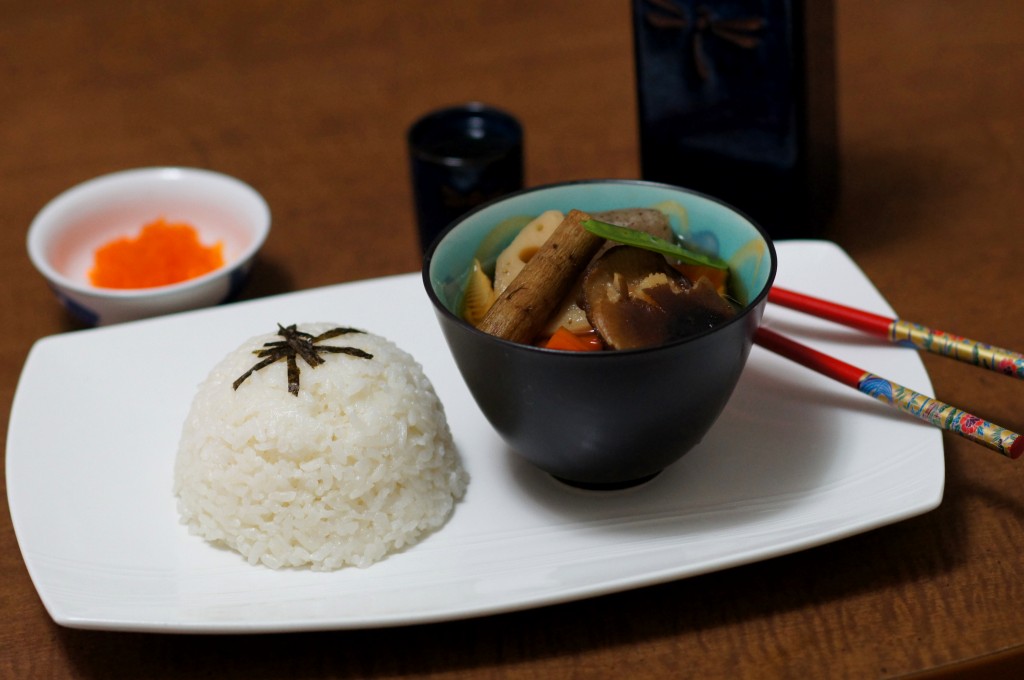
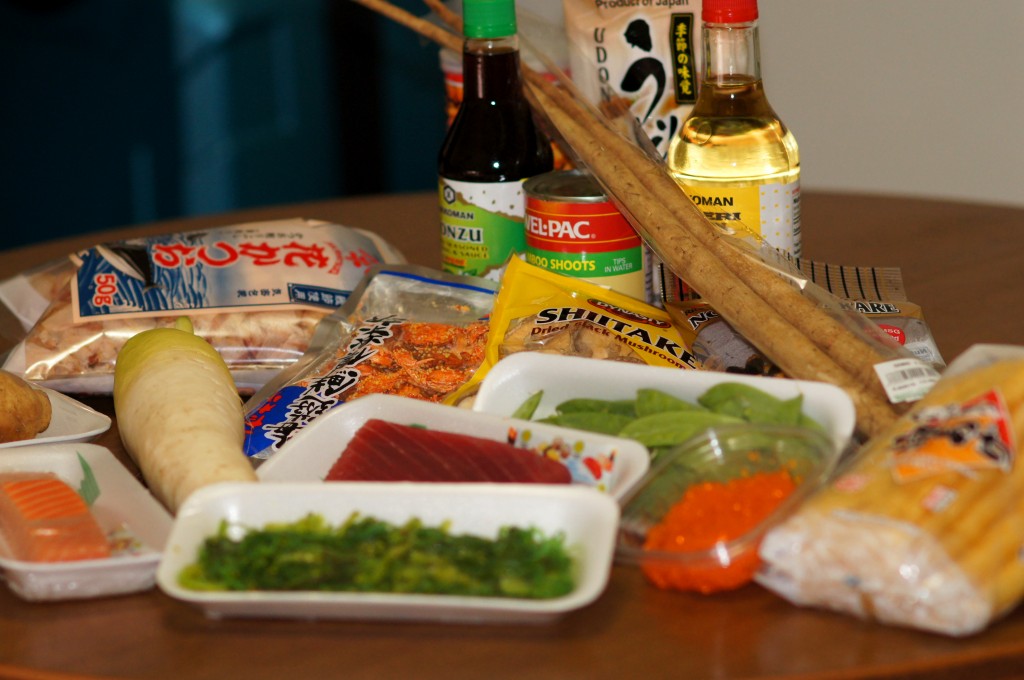
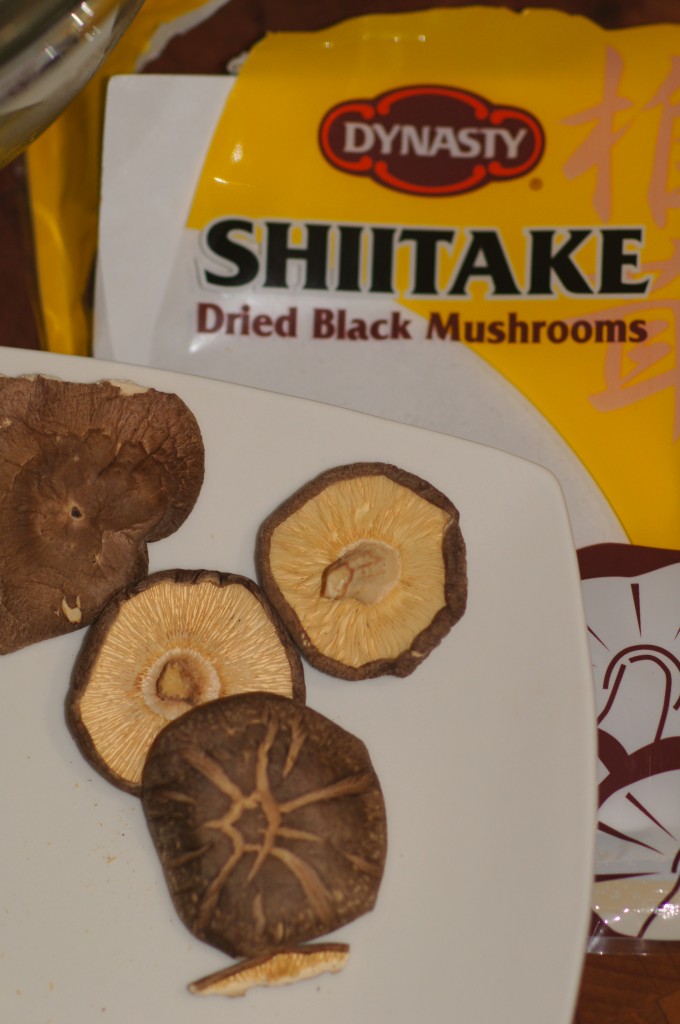
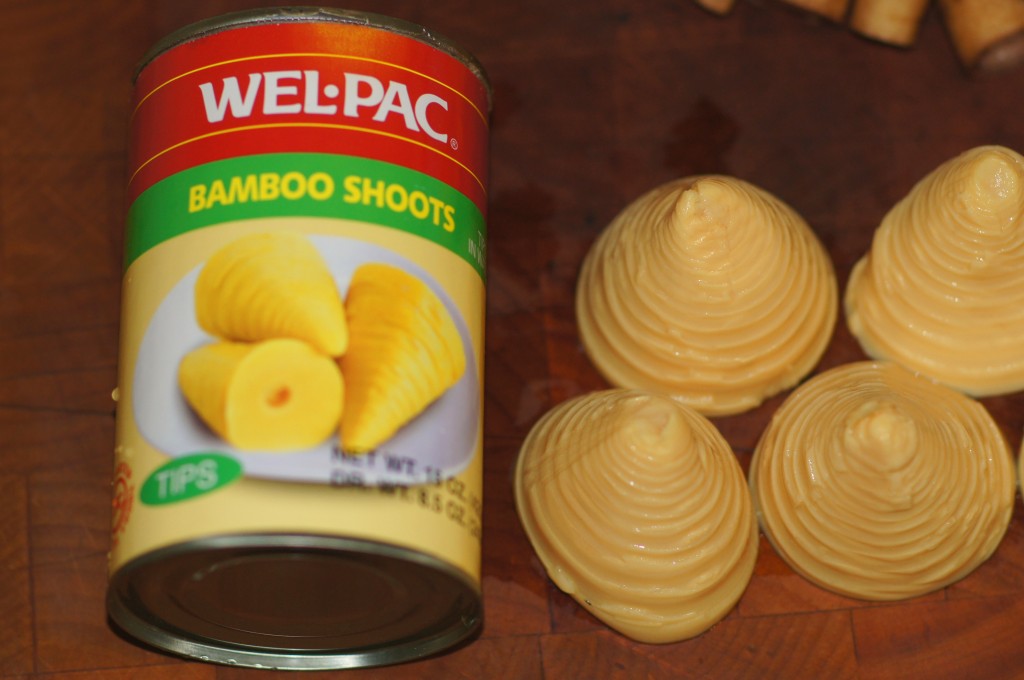
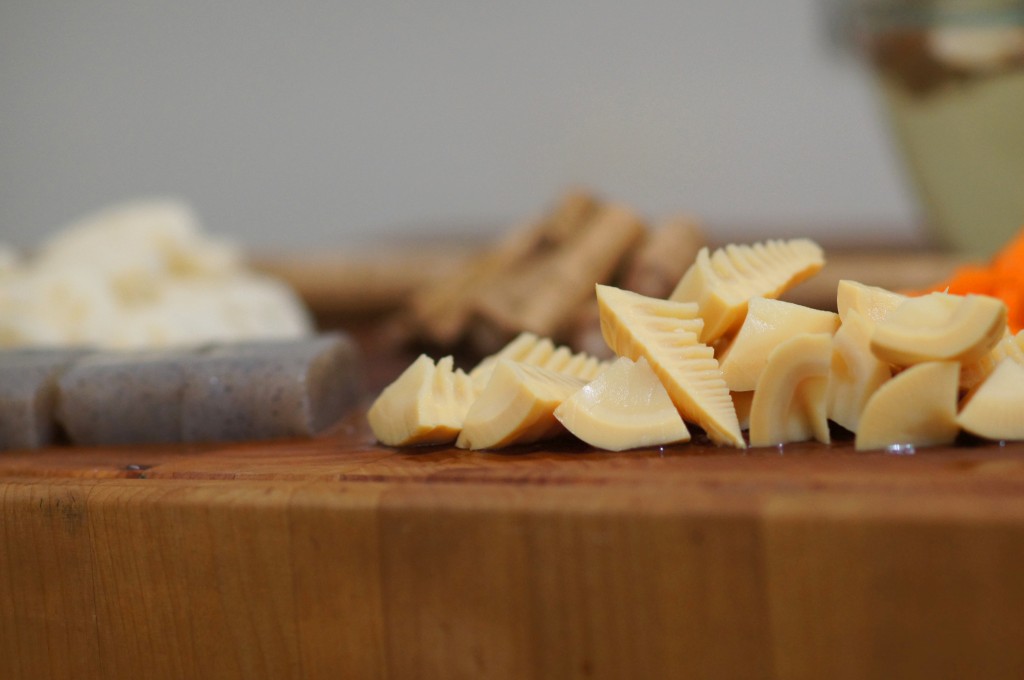
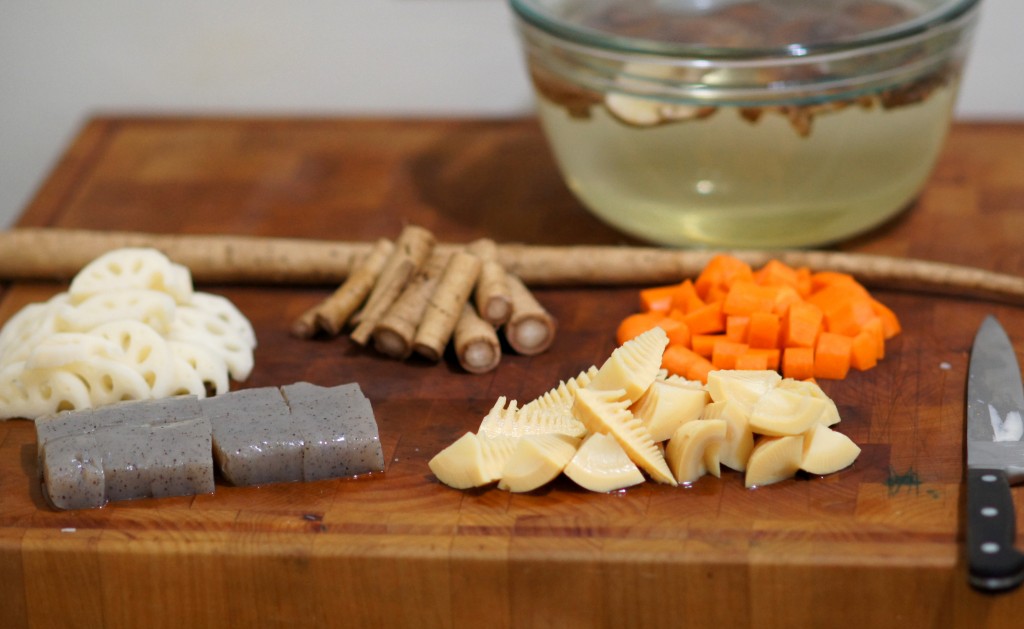
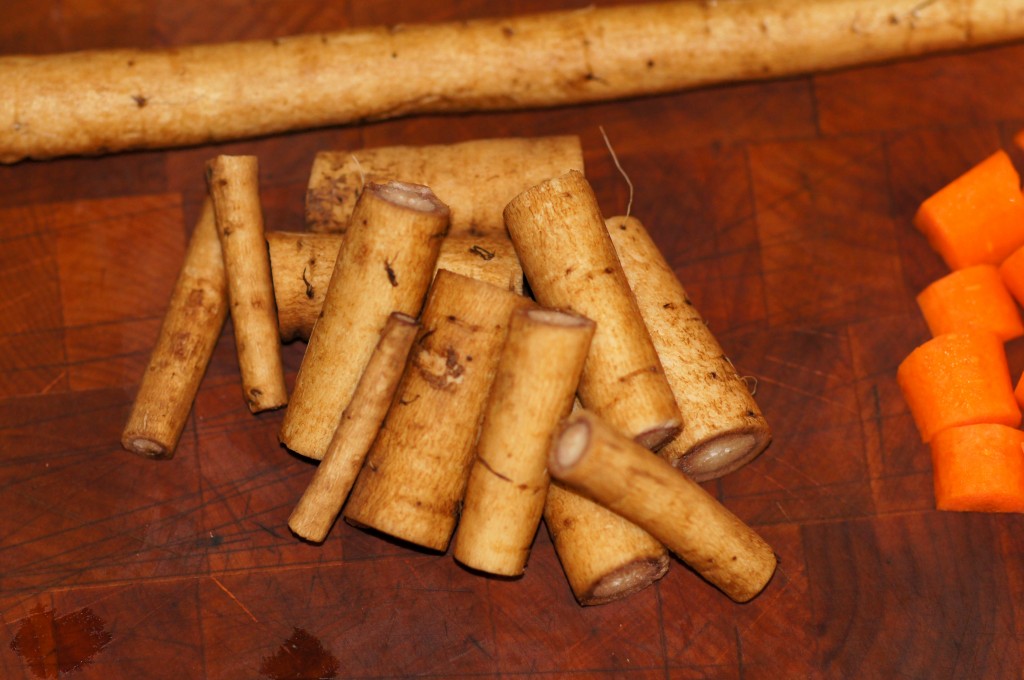
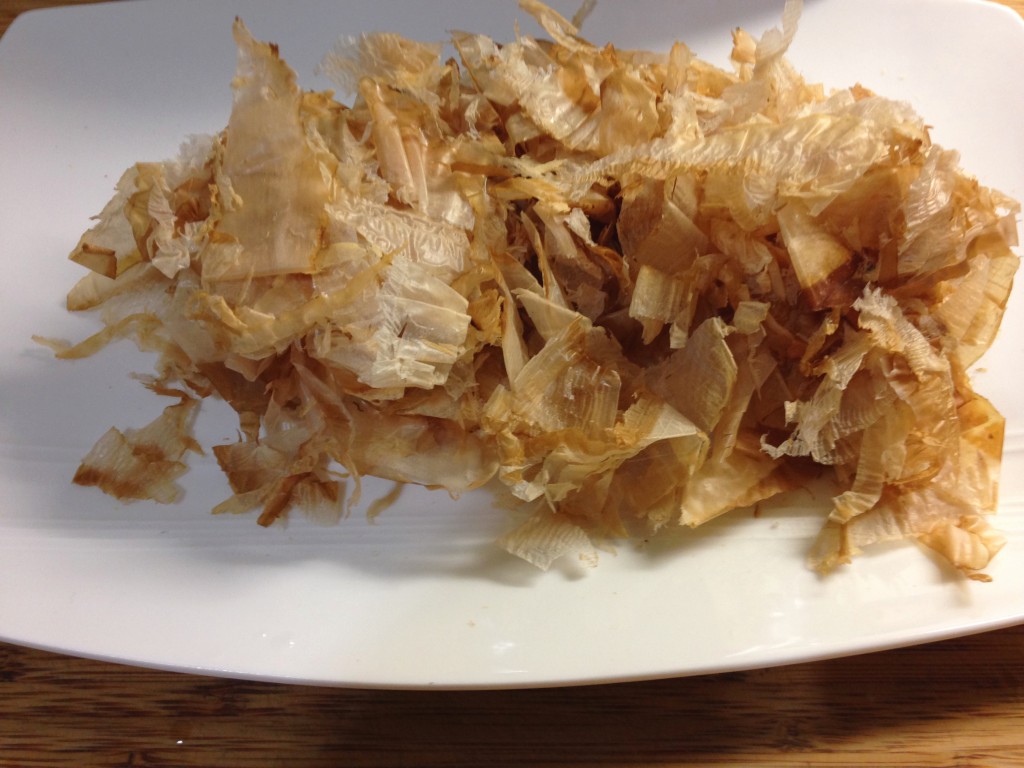
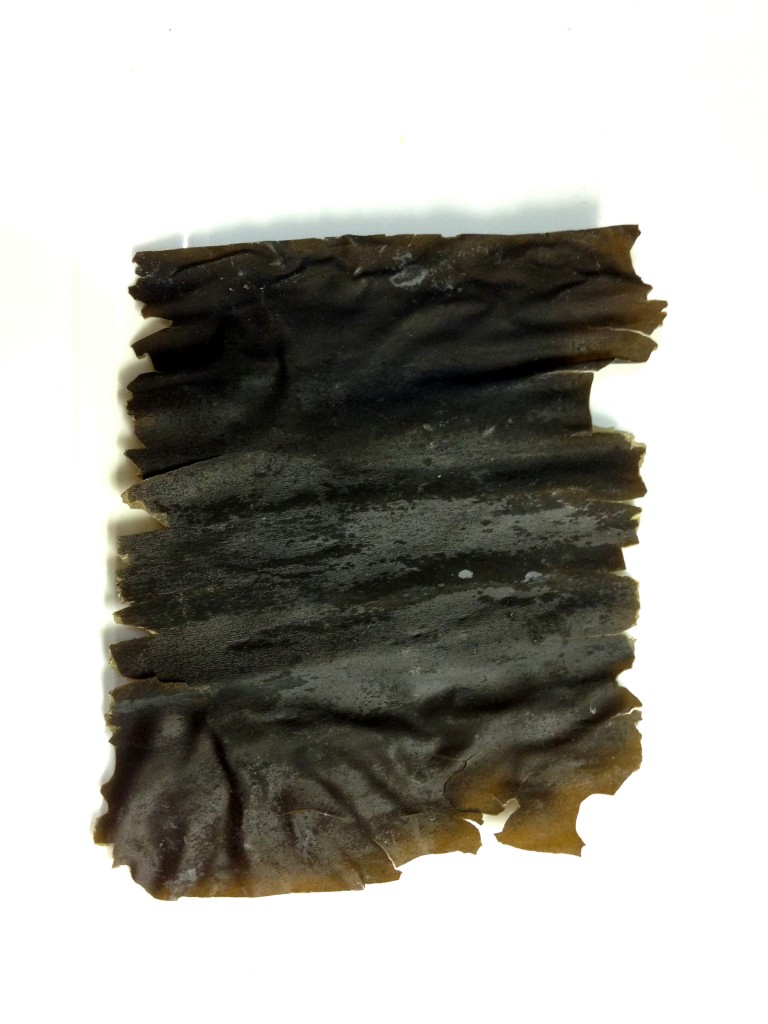
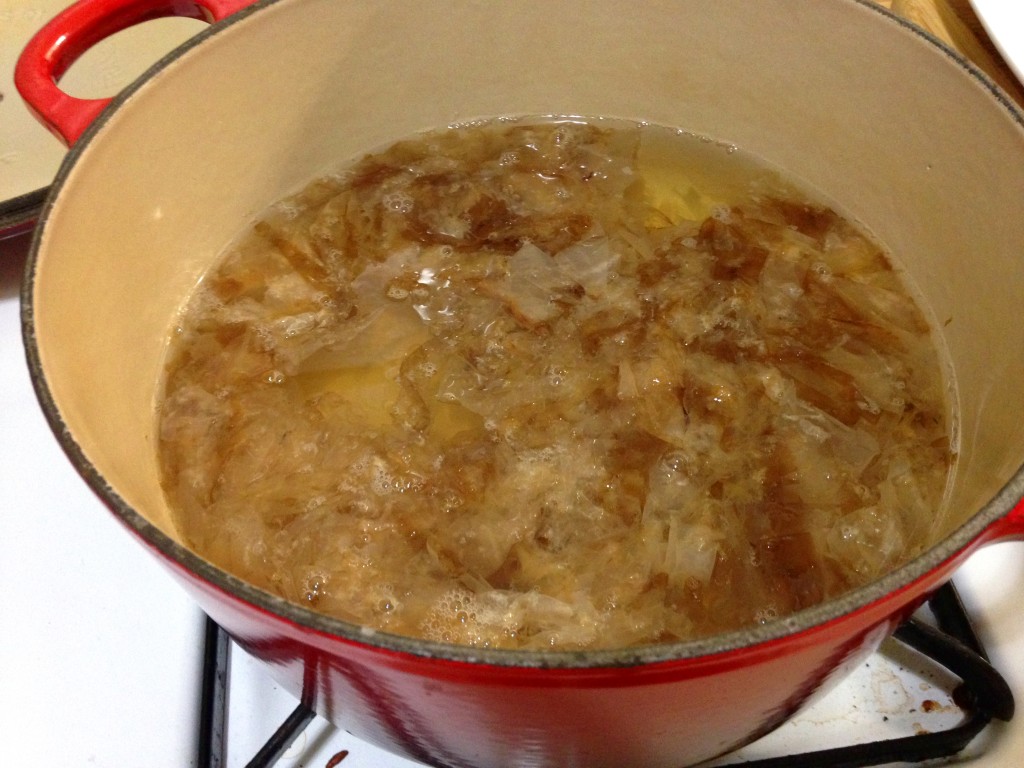
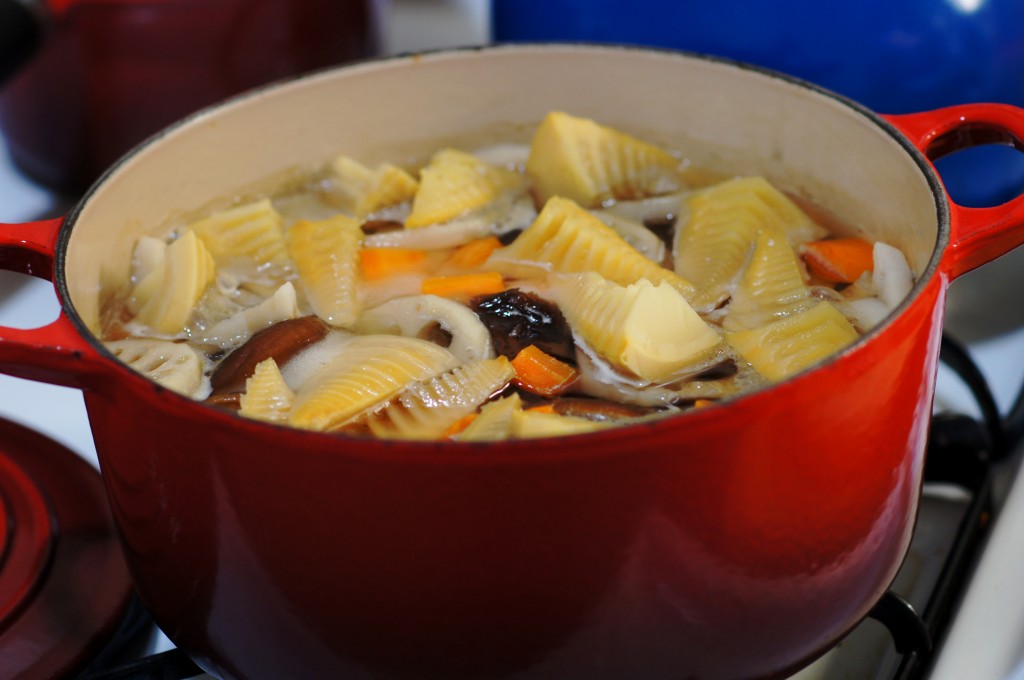
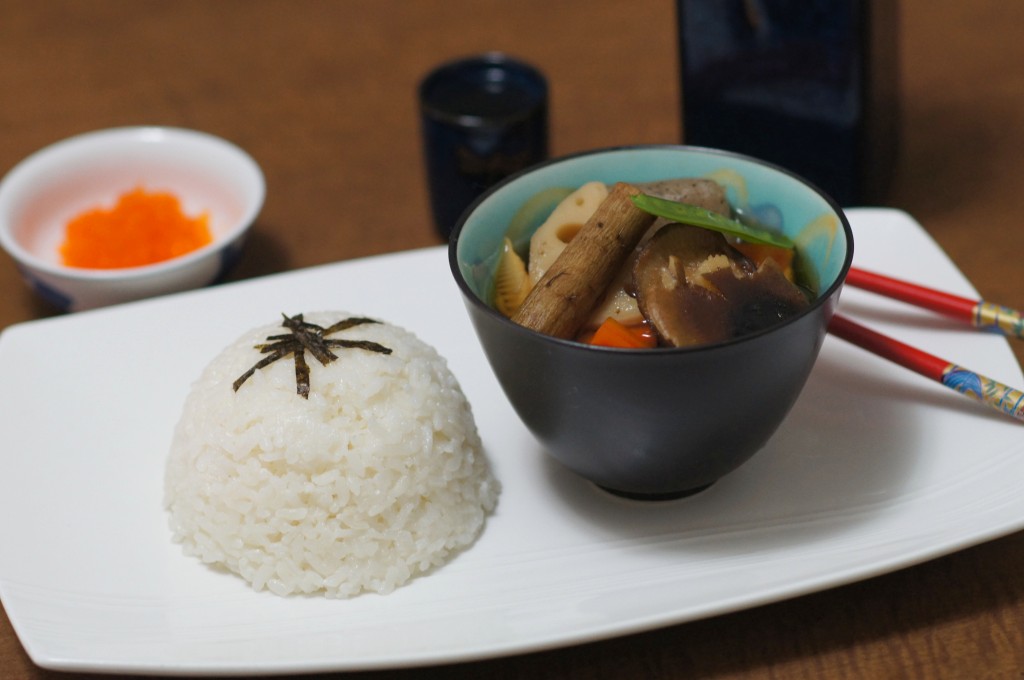
 Print recipe
Print recipe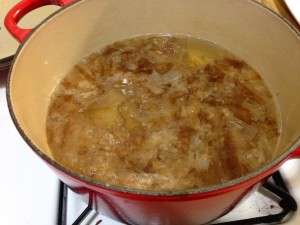
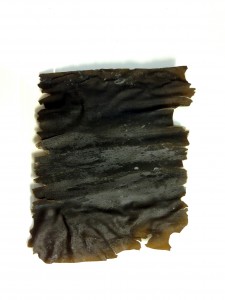
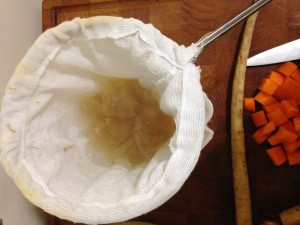
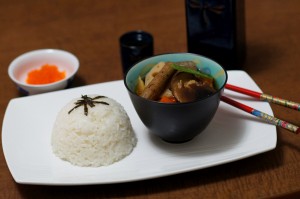
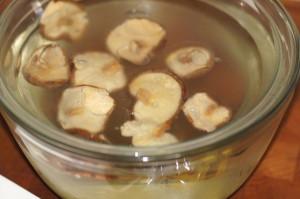


Great recipe! I love simmered burdock root (Kinpira Gobo), but it’s so much work that I usually just go for the konnyaku instead. They also taste great in soup. I love Konnyaku noodles when I do nabe/hot pot. 🙂
I’m glad you like the recipe, Amy! I’m going to have to try konnyaku noodles the next time I make hot pot. Sounds delicious. Thanks for stopping by!